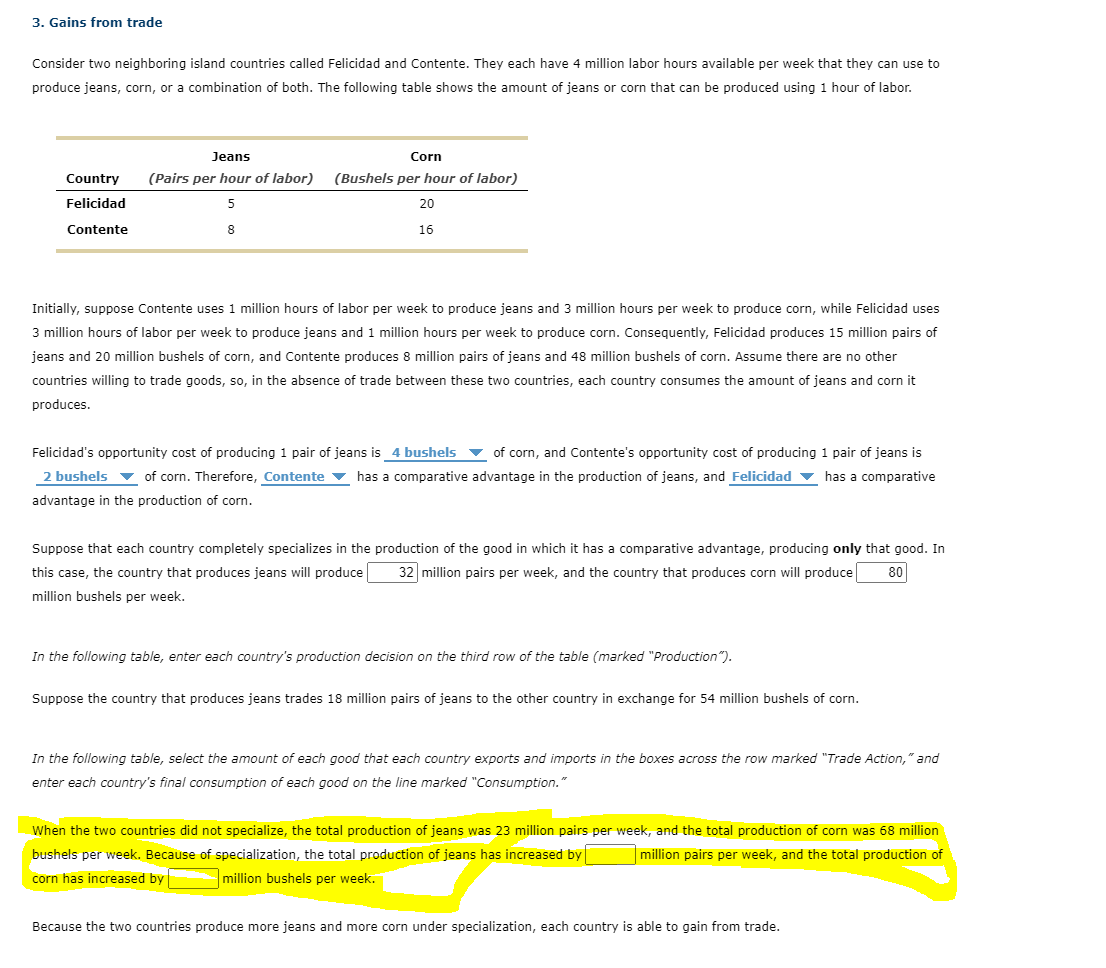When the two countries did not specialize, the total production of jeans was 23 million pairs per week, and the total production of corn was 68 million bushels per week. Because of specialization, the total production of jeans has increased by million pairs per week, and the total production of corn has increased by million bushels per week.
When the two countries did not specialize, the total production of jeans was 23 million pairs per week, and the total production of corn was 68 million bushels per week. Because of specialization, the total production of jeans has increased by million pairs per week, and the total production of corn has increased by million bushels per week.
Essentials of Economics (MindTap Course List)
8th Edition
ISBN:9781337091992
Author:N. Gregory Mankiw
Publisher:N. Gregory Mankiw
Chapter3: Interdependence And The Gains From Trade
Section: Chapter Questions
Problem 4PA
Related questions
Question
can you help me answer only the highlighted in the attached please

Transcribed Image Text:3. Gains from trade
Consider two neighboring island countries called Felicidad and Contente. They each have 4 million labor hours available per week that they can use to
produce jeans, corn, or a combination of both. The following table shows the amount of jeans or corn that can be produced using 1 hour of labor.
Jeans
Corn
Country
(Pairs per hour of labor)
(Bushels per hour of labor)
Felicidad
5
20
Contente
8
16
Initially, suppose Contente uses 1 million hours of labor per week to produce jeans and 3 million hours per week to produce corn, while Felicidad uses
3 million hours of labor per week to produce jeans and 1 million hours per week to produce corn. Consequently, Felicidad produces 15 million pairs of
jeans and 20 million bushels of corn, and Contente produces 8 million pairs of jeans and 48 million bushels of corn. Assume there are no other
countries willing to trade goods, so, in the absence of trade between these two countries, each country consumes the amount of jeans and corn it
produces.
Felicidad's opportunity cost of producing 1 pair of jeans is 4 bushels v of corn, and Contente's opportunity cost of producing 1 pair of jeans is
2 bushels v of corn. Therefore, Contente v has a comparative advantage in the production of jeans, and Felicidad v has a comparative
advantage in the production of corn.
Suppose that each country completely specializes in the production of the good in which it has a comparative advantage, producing only that good. In
this case, the country that produces jeans will produce
32 million pairs per week, and the country that produces corn will produce
80
million bushels per week.
In the following table, enter each country's production decision on the third row of the table (marked "Production").
Suppose the country that produces jeans trades 18 million pairs of jeans to the other country in exchange for 54 million bushels of corn.
In the following table, select the amount of each good that each country exports and imports in the boxes across the row marked "Trade Action," and
enter each country's final consumption of each good on the line marked "Consumption."
When the two countries did not specialize, the total production of jeans was 23 million pairs per week, and the total production of corn was 68 million
bushels per week. Because of specialization, the total production of jeans has increased by
million pairs per week, and the total production of
corn has increased by
million bushels per week.
Because the two countries produce more jeans and more corn under specialization, each country is able to gain from trade.
Expert Solution
This question has been solved!
Explore an expertly crafted, step-by-step solution for a thorough understanding of key concepts.
This is a popular solution!
Trending now
This is a popular solution!
Step by step
Solved in 4 steps

Knowledge Booster
Learn more about
Need a deep-dive on the concept behind this application? Look no further. Learn more about this topic, economics and related others by exploring similar questions and additional content below.Recommended textbooks for you

Essentials of Economics (MindTap Course List)
Economics
ISBN:
9781337091992
Author:
N. Gregory Mankiw
Publisher:
Cengage Learning

Brief Principles of Macroeconomics (MindTap Cours…
Economics
ISBN:
9781337091985
Author:
N. Gregory Mankiw
Publisher:
Cengage Learning

Principles of Economics 2e
Economics
ISBN:
9781947172364
Author:
Steven A. Greenlaw; David Shapiro
Publisher:
OpenStax

Essentials of Economics (MindTap Course List)
Economics
ISBN:
9781337091992
Author:
N. Gregory Mankiw
Publisher:
Cengage Learning

Brief Principles of Macroeconomics (MindTap Cours…
Economics
ISBN:
9781337091985
Author:
N. Gregory Mankiw
Publisher:
Cengage Learning

Principles of Economics 2e
Economics
ISBN:
9781947172364
Author:
Steven A. Greenlaw; David Shapiro
Publisher:
OpenStax